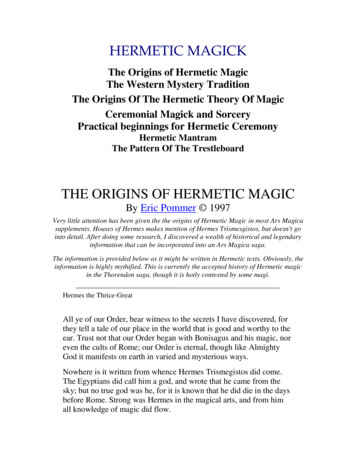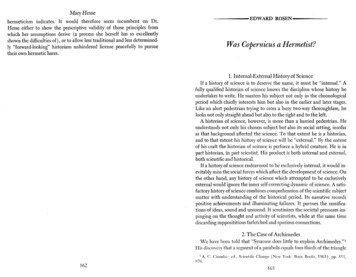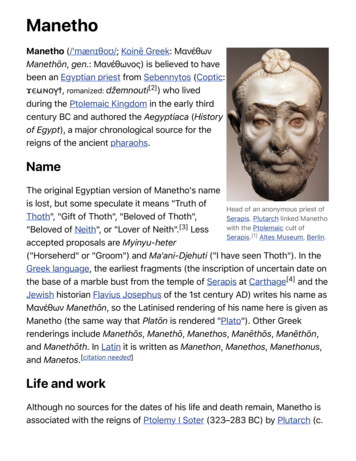
Transcription
Hermes, Hermeticism, andRelatedEight Wikipedia ArticlesPDF generated using the open source mwlib toolkit. See http://code.pediapress.com/ for more information.PDF generated at: Wed, 11 May 2011 01:25:11 UTC
ContentsArticlesHermes1Hermes tic Qabalah37Emerald Tablet41Kybalion45ReferencesArticle Sources and Contributors50Image Sources, Licenses and Contributors52Article LicensesLicense53
Hermes1HermesHermesSo-called “Logios Hermes” (Hermes,Orator). Marble, Roman copy from the late 1st century CE - early 2nd century CE after a Greek original of the5th century BCE.Messenger of the godsGod of commerce, thieves, travelers, sports, athletes, and border crossings, guide to the UnderworldAbodeMount OlympusSymbolCaduceus, Talaria, Tortoise, Lyre, Rooster,ConsortMerope, Aphrodite, Dryope, PeithoParentsZeus and MaiaRoman equivalentMercuryHermes ( /ˈhɜrmiːz/; Greek Ἑρμῆς) is the great messenger of the gods in Greek mythology and a guide to theUnderworld. Hermes was born on Mount Cyllene in Arcadia. An Olympian god, he is also the patron of boundariesand of the travelers who cross them, of shepherds and cowherds, of the cunning of thieves,[1] of orators and wit, ofliterature and poets, of athletics and sports, of weights and measures, of invention, and of commerce in general.[2]His symbols include the tortoise, the rooster, the winged sandals, the winged hat, and the caduceus.In the Roman adaptation of the Greek religion (see interpretatio romana), Hermes was identified with the Romangod Mercury, who, though inherited from the Etruscans, developed many similar characteristics, such as being thepatron of commerce.The Homeric hymn to Hermes invokes him as the one "of many shifts (polytropos), blandly cunning, a robber, acattle driver, a bringer of dreams, a watcher by night, a thief at the gates, one who was soon to show forth wonderfuldeeds among the deathless gods."[3]He protects and takes care of all the travelers, miscreants, harlots, old crones and thieves that pray to him or cross hispath. He is athletic and is always looking out for runners, or any athletes with injuries who need his help.Hermes is a messenger from the gods to humans, sharing this role with Iris. An interpreter who bridges theboundaries with strangers is a hermeneus. Hermes gives us our word "hermeneutics", the study and theory ofinterpretation. In Greek a lucky find was a hermaion. Hermes delivered messages from Olympus to the mortal world.He wears shoes with wings on them and uses them to fly freely between the mortal and immortal world. Hermes wasthe second youngest of the Olympian gods, being born before Dionysus.Hermes, as an inventor of fire,[4] is a parallel of the Titan, Prometheus. In addition to the lyre, Hermes was believedto have invented many types of racing and the sports of wrestling and boxing, and therefore was a patron ofathletes.[5]According to prominent folklorist Yeleazar Meletinsky, Hermes is a deified trickster.[6] Hermes also served as apsychopomp, or an escort for the dead to help them find their way to the afterlife (the Underworld in the Greek
Hermesmyths). In many Greek myths, Hermes was depicted as the only god besides Hades, Persephone, Hecate, andThanatos who could enter and leave the Underworld without hindrance.Hermes often helped travelers have a safe and easy journey. Many Greeks would sacrifice to Hermes before any trip.In the fully-developed Olympian pantheon, Hermes was the son of Zeus and the Pleiade Maia, a daughter of theTitan Atlas. Hermes' symbols were the rooster and the tortoise, and he can be recognized by his purse or pouch,winged sandals, winged cap, and the herald's staff, the kerykeion. The night he was born he slipped away from Maiaand stole his elder brother Apollo's cattle.EtymologyThe earliest form of the name Hermes is the Mycenaean Greek e-ma-ha, written in Linear B syllabic script. Howeverthe identification of the name is unclear, and its etymology is controversial. Some claim it is simply unknown, or notof Greek origin. It may have derived from Hermeneus, which means the interpreter.[7] [8] [9] Plato, giving voice toSocrates, tried to establish an origin of the name, saying that Hermes was tied to speech, interpretation andtransmission of messages, all activities connected to the power of speech (eirei), and that in course of time eirein wasembellished and turned into Hermes.[9] The most common idea is that it was derived from herm, a sacredboundary-marker or road-altar, dedicated to Hermes since ancient times. Nilsson and Guthrie believe it means "oneCairn," a primitive form of Hermes, but this source is also disputed.[8] [10]MythologyThe origin of Hermes is uncertain. Some consider hima native god that was worshiped since the Neolithic era,while others suggests that he was an Asian import,perhaps via Cyprus or Cilicia well before the beginningof written records in Greece. What seems certain is thathis cult was established in Greece in remote regions,likely making him a god of nature, farmers andshepherds. It is also possible that since the beginning hehas been a deity with shamanic attributes linked todivination, atonement, magic, sacrifices, and initiationand contact with other planes of existence, a role ofmediator between the visible and invisible worlds.[11]Hermes with his mother Maia. Detail of the side B of an AtticAmong the functions most commonly linked to him inred-figure belly-amphora, ca. 500 BC.Greek literature are messenger of the gods, and god oflanguage, speech, metaphors , prudence and circumspection, as well as intrigues and covert reasons, fraud andperjury, wit and ambiguity. Thus he was a patron of speakers, heralds, ambassadors and diplomats, messengers andthieves. He was believed to have invented fire, the lira, the syrinx, the alphabet, the numbers, to astronomy, a specialform of music, the arts of fighting, the gym and the cultivation of olive trees, the measures, the weights and variousother things.By his constant mobility and other intellectual and relational, he was considered the god of commerce and socialintercourse, the wealth brought in business, especially sudden or unexpected enrichment, travel, roads andcrossroads, borders and boundary conditions or transient, the changes from the threshold, agreements and contracts,friendship, hospitality, sexual intercourse, was the god of game data, the draw, good luck, the sacrifices and thesacrificial animals, flocks and shepherds and the fertility of land and cattle. In addition to serving as messenger toZeus, Hermes carried the souls of the dead to Hades, and directed the dreams sent by Zeus to mortals.[12] [13] [14]2
HermesEarly Greek sourcesThe first descriptions of the myth of Hermes date fromthe Archaic period of Ancient Greece. One of the mostimportant myths appears in the Homeric Hymn toHermes, dating to the seventh or sixth centuries BC anddeals with his birth and early exploits. The hymn openswith a salutation to the god, calling him the lord ofMount Cyllene and Arcadia, the flocks of sheep, andmessenger of the gods. It also names him as the son ofZeus, the result of his adulterous love with Maia, anymph daughter of Atlas and Pleione. Living in a cave,hidden from human eyes and particularly thenotoriously stormy and jealous Hera, Zeus' wife andsister, Maia gave birth to "this ingenious child, thisclever deception planner, tracker and capturer ofcattle, a shepherd of dreams, this citizen of the nightlurking in doorways." The infant Hermes wasprecocious. His first day he invented the lyre. Bynightfall, he had rustled the immortal cattle of Apollo.Kriophoros Hermes (which takes the lamb), late-Roman copy ofGreek original from the fifth century BC. Barracco Museum, RomeFor the first sacrifice, the taboos surrounding the sacredkine of Apollo had to be transgressed, and the trickstergod of boundaries was the one to do it. Hermes drove the cattle back to Greece and hid them, walking thembackwards so that their tracks seemed to be going in the wrong direction. When Apollo accused Hermes, Maia saidthat it could not be him because he was with her the whole night. However, Zeus entered the argument and said thatHermes did steal the cattle and they should be returned. While arguing with Apollo, Hermes began to play his lyre.The instrument enchanted Apollo and he agreed to let Hermes keep the cattle in exchange for the lyre.Homer and Hesiod portrayed Hermes as the author of skilled or deceptive acts, and also as a benefactor of mortals.In the Iliad he was called "the bringer of good luck," "guide and guardian" and "excellent in all the tricks." He was adivine ally of the Greeks against the Trojans. However, he did protect Priam when he went to the Greek camp toretrieve the body of his son Hector. When Priam got it, Hermes took them back to Troy.[15] He also rescued Aresfrom a brazen vessel where he had been imprisoned by Otus and Ephialtes. In the Odyssey he helped the protagonist,Odysseus, informing him about the fate of his companions, who were turned into animals by the power of Circe, andinstructed him to protect himself by chewing a magic herb; he also told Calipso Zeus' order for her to free the samehero from her island to continue his journey back home. When Odysseus killed the suitors of his wife, Hermes leadtheir souls to Hades .[16] In The Works and Days, when Zeus ordered Hephaestus to create Pandora to disgracehumanity by punishing the act of Prometheus giving fire to man , every god gave her a gift, and Hermes’ gift was liesand seductive words, and a dubious character. Then he was instructed to take her as wife to Epimetheus.[17]There are plenty of other myths featuring Hermes. Aeschylus wrote that Hermes helped Orestes kill Clytemnestraunder a false identity and other stratagems,[18] and also said that he was the god of searches, and those who seekthings lost or stolen.[19] Sophocles wrote that Odysseus invoked him when he needed to convince Philoctetes to jointhe Trojan War on the side of the Greeks, and Euripides did appear to help in spy Dolon Greek navy.[18] Aesop, whoallegedly had literary received his talents from Hermes, put him in several of its fables, as ruler of the gate ofprophetic dreams, as the god of athletes, edible roots, hospitality. He also said that Hermes had assigned each personhis share of intelligence.[20] Pindar and Aristophanes also document his recent association with the gym, which didnot exist at the time of Homer.[21]3
HermesHellenistic Greek sourcesSeveral writers of the Hellenistic period expanded the list of Hermes’ achievements. Callimachus said he disguisedhimself as a cyclops to scare the Oceanides and was disobedient to his mother.[22] One of the Orphic HymnsKhthonios is dedicated to Hermes, indicating that he was also a god of the underworld. Aeschylus had called him bythis epithet several times.[23] Another is the Orphic Hymn to Hermes, where his association with the athletic gamesheld in tone is mystic.[24] Phlegon of Tralles said he was invoked to ward off ghosts,[25] and Pseudo-Apollodorusreported several events involving Hermes. He participated in the Gigantomachy in defense of Olympus; was giventhe task of bringing baby Dionysius to be cared for by Ino and Athamas and later by nymphs of Asia, followed Hera,Athena and Aphrodite in a beauty contest; favored the young Hercules by giving him a sword when he finished hiseducation and lent his sandals to Perseus.[26] The Thracian princes identified him with their god Zalmoxis,considering his ancestor.[27]Throughout the Hellenistic period, Hermes acquired a particularly important status as an image of Logos andinterpreter of the divine will, and went from being a mere expressive character to acting creatively, taking on roles ofdemiurge, an change which is mainly attributed to the Stoics, Gnostics and Neoplatonists. Apparently, this timebegan the merger of Hermes with the Egyptian god Thoth, who flourished as the figure of Hermes Trismegistus.Epithets of HermesKriophorosHermes Kriophoros, Hermes, lamb-bearer appears both early and later. His ram connection appears in the earliestMycenaean Linear B inscription bearing his name. Pausanias reports the lamb-carrying rites still being performed atthe Boeotian city of Tanagra in the late 2nd century CE.ArgeiphontesHermes' epithet Argeiphontes (Latin Argicida), or Argus-slayer, recalls his slaying of the hundred eyed giant ArgusPanoptes, who was watching over the heifer-nymph Io in the sanctuary of Queen Hera herself in Argos. PuttingArgus to sleep, Hermes used a spell to close all of Argus' eyes and then slew the giant. Argus' eyes were then putinto the tail of the peacock, symbol of the goddess Hera.4
Hermes5LogiosHis epithet of Logios is the representation of the god in the act of speaking, asorator, or as the god of eloquence. Indeed, together with Athena, he was thestandard divine representation of eloquence in classical Greece. The HomericHymn to Hermes (probably 6th century BCE) describes Hermes making asuccessful speech from the cradle to defend himself from the (true) charge ofcattle theft. In the 5th century BCE Proclus' commentary on Plato's Republicdescribes Hermes as the god of persuasion. Other Neoplatonists viewedHermes Logios more mystically as origin of a "Hermaic chain" of light andradiance emanating from the divine intellect (nous). This epithet alsoproduced a sculptural type.OtherOther epithets included: Agoraeus, of the agora[28] Acacesius, of Acacus Argiphontes, slayer or Argus [] Charidotes, giver of charm Cyllenius, born on Mount Cyllene Diaktoros, the messenger Dolios, the schemer Enagonios, lord of contests Enodios, on the road Epimelios, guardian of flocks [] Eriounios, luck bringer Hodios patron of travelers and wayfarers []Oneiropompus, conductor of dreams []PolygiusPsychopompos, conveyor of soulsTrismegistus, later in HermeticismHermes o Logios as the name (and thegod as the emblem) of a Greek literarymagazine of the 18th and 19th c. whichhad a major role in Modern GreekEnlightenment.
Hermes6Worship and cultOne of the oldest places of worship for Hermes was Mount Cilene in Arcadia,where the myth says that he was born. Tradition says that his first temple wasbuilt by Lycaon. From there the cult would have been taken to Athens, andthem radiate to the whole of Greece, according to Smith, and his temples andstatues became extremely numerous.[12] Lucian of Samosata said he saw thetemples of Hermes everywhere.[29] In many places, his temple wasconsecrated in conjunction with Aphrodite, as in Attica, Arcadia, Crete,Samos and in Magna Graecia. Several ex-votos found in his temples revealedhis role as initiator of young adulthood, among them soldiers and hunters,since war and certain forms of hunting were seen as ceremonial initiatoryordeals. This function of Hermes explains why some images in temples andother vessels show him as a teenager. As a patron of the gym and fighting,Hermes had statues in gyms and he was also worshiped in the sanctuary ofthe Twelve Gods in Olympia, where Greeks celebrated the Olympic Games.His statue was held there on an altar dedicated to him and Apollo together.[30]Hermes’ feast was the special Hermaea was celebrated with sacrifices to thegod and with athletics and gymnastics, possibly having been established inthe sixth century BC, but no documentation on the festival before the fourthcentury BC survives. However, Plato said that Socrates attended a Hermaea.Of all the festivals involving Greek games, these were the most likeinitiations because participation in them was restricted to young boys andexcluded adults.[31] Having an initiatory character, the winners of Hermaeareturned to their villages as heroes and adults who had acquired honor. TheHermaea of Pellene became particularly busy, attracting competitors fromdistant regions. His prize was a thick mantle.Archaic Greek herm, presumably ofHermes, unusual in that the penis hassurvived.Symbols of Hermes were the palm tree, turtle, rooster, goat, the number four, several kinds of fish, incense.Sacrifices involved honey, cakes, pigs, goats, lambs and young people. In the sanctuary of Hermes Promakhos inTanagra is a strawberry tree under which it was believed he had created,[32] and in the hills Phene ran three sourcesthat were sacred to him, because he believed that there had been bathed at birth. A statue of Hermes guarded theentrance to the temple of Apollo at Thebes, and there were some at Tanagra in which he appeared with a lamb(Kriophoros), because a legend said that he departed from the plague of the city carrying a lamb around the walls.Homer said the latest libations of a banquet were dedicated to Hermes, and Pausanias, who in his time had theirstatues in all gyms, following an ancient custom which was now being copied by the barbarians. In many cities therewas a statue of him in the marketplaces. One form of worship was oracular, as established in the Pharaoh. In themarket town once stood a statue of Hermes Agoraios, of which he had a heart carved in stone, with two oil lampsfastened with leather straps.Hermai/HermsIn Ancient Greece, Hermes was a phallic god of boundaries. His name, in the form herma, was applied to a waysidemarker pile of stones; each traveller added a stone to the pile. In the 6th century BCE, Hipparchos, the son ofPisistratus, replaced the cairns that marked the midway point between each village deme at the central agora ofAthens with a square or rectangular pillar of stone or bronze topped by a bust of Hermes with a beard. An erectphallus rose from the base. In the more primitive Mount Kyllini or Cyllenian herms, the standing stone or woodenpillar was simply a carved phallus. In Athens, herms were placed outside houses for good luck. "That a monument of
Hermesthis kind could be transformed into an Olympian god is astounding," Walter Burkert remarked.[33]In 415 BCE, when the Athenian fleet was about to set sail for Syracuse during the Peloponnesian War, all of theAthenian hermai were vandalized one night. The Athenians at the time believed it was the work of saboteurs, eitherfrom Syracuse or from the anti-war faction within Athens itself. Socrates' pupil Alcibiades was suspected ofinvolvement, and Socrates indirectly paid for the impiety with his life.From these origins, hermai moved into the repertory of Classical architecture.Hermes' offspringPanThe satyr-like Greek god of nature, shepherds and flocks, Pan, was often said to be the son of Hermes through thenymph Dryope.[34] In the Homeric Hymn to Pan, Pan's mother ran away from the newborn god in fright from hisgoat-like appearance.HermaphroditusHermaphroditus was an immortal son of Hermes through Aphrodite. He was changed into an androgynous being, acreature of both sexes, when the gods literally granted the nymph Salmacis' wish, that she and Hermaphroditus werenever separated after she embraced him passionately in a pool. He then cursed the pool, saying any man who enteredit would lose his masculinity.PriapusDepending on the sources consulted, the god Priapus could be understood as a son of Hermes.[35] In Priapus,Hermes' phallic origins survived.ErosAccording to some sources, the mischievous winged god of love Eros, son of Aphrodite, was sired by Hermes,though the gods Ares and Hephaestus were also among those said to be the sire, whereas in the Theogony, Hesiodclaims that Eros was born of nothing before the Gods. Eros' Roman name was Cupid. Eros also has magical arrows,with which he can cause any mortal to fall in love with the next being they see, human or otherwise.TycheThe goddess of prosperity, Tyche (Greek, Τύχη) or Fortuna, was sometimes said to be the daughter of Hermes andAphrodite.AbderusAbderus was devoured by the Mares of Diomedes. He had gone to the Mares with his friend Heracles.AutolycusAutolycus, the Prince of Thieves, was a son of Hermes and grandfather of Odysseus.List of Hermes' lovers and children1. Acacallis1. Cydon2. Aglaurus7
Hermes81. Eumolpus3. Amphion[36]4. Alcidameia of Corinth1. Bounos5. Antianeira1. Echion, Argonaut2. Erytus, Argonaut6. Apemosyne7. Aphrodite1. Eros (possibly)2. Hermaphroditus3. Tyche (possibly)8. Carmentis1. Evander9. Chione / Stilbe / Telauge[37]1. Autolycus10. Chryses, priest of Apollo11. Chthonophyle1. Polybus of Sicyon12. Crocus13. Daeira the Oceanid1. Eleusis14. Dryope, Arcadian nymph1. Pan (possibly)15. Erytheia (daughter of Geryones)1. Norax[38]16. Eupolemeia (daughter of Myrmidon)1. Aethalides17. Hecate1. three unnamed daughters[39]18. Herse1. Cephalus2. Ceryx (possibly)19. Hiereia1. Gigas[40]20. Iphthime (daughter of Dorus)1. Lycus2. Pherespondus3. Pronomus21. Libye (daughter of Palamedes)1. Libys[41]22. Ocyrhoe1. Caicus23. Pandrosus
Hermes91. Ceryx (possibly)24. Peitho25. Penelope1. Pan (possibly)26. Persephone (unsuccessfully wooed her)27. Phylodameia1. Pharis28. Polymele (daughter of Phylas)1. Eudorus29. Rhene, nymph1. Saon of Samothrace[42]30. Sicilian nymph1. Daphnis31. Sose, nymph1. Pan (possibly)32. Tanagra, daughter of Asopus33. Theobula / Clytie / Clymene / Cleobule / Myrto / Phaethusa the Danaid1. Myrtilus34. Therses35. Thronia1. Arabus36. Urania, Muse1. Linus (possibly)37. Unknown mother1. Abderus2. Angelia3. Palaestra
HermesArt and iconographyThe image of Hermes evolved and varied according to Greekart and culture. During Archaic Greece he was usuallydepicted as a mature man, bearded, dressed as a traveler,herald, or pastor. During Classical and Hellenistic Greece heis usually depicted young and nude, with athleticism, asbefits the god of speech and of the gymnastics, or a robe, aformula is set predominantly through the centuries. Whenrepresented as Logios (speaker), his attitude is consistentwith the attribute. Phidias left a statue of a famous HermesLogios, represented at the opening of the article, andPraxiteles another, also well known, showing him withDionysius baby arms. At all times, however, through theHellenistic periods, Roman, and throughout Western historyinto the present day, several of his characteristic objects arepresent as identification, but not always all together.[12] [43]Among these objects is a wide-brimmed hat, the Petasos,widely used by rural people of antiquity to protectArchaic bearded Hermes from a herm, early 5th century BC.themselves from the sun, and that in later times was adornedwith a pair of small wings, sometimes the hat is not present,but may then have wings rising from the hair. Another objectis the Porta a stick, called rhabdomyolysis (stick) or skeptron(scepter), which is referred to as a magic wand. Some earlysources say that this was the bat he received from Apollo, butothers question the merits of this claim. It seems that theremay have been two canes, with time in a cast, one of ashepherd's staff, as stated in the Homeric Hymn, and theother a magic wand, according to some authors. His bat alsocame to be called kerykeion, the caduceus, in later times.Early depictions of the staff it show it as a baton stick toppedby a golden way that resembled the number eight, thoughsometimes with its top truncated and open. Later the staffhad two intertwined snakes and sometimes it was crownedwith a pair of wings and a ball, but the old form remained inuse even when Hermes was associated with Mercury by theHermes Fastening his Sandal, early Imperial Roman marbleRomans.[12] [44] Hyginus explained the presence of snakes,copy of a Lysippan bronze (Louvre Museum)saying that Hermes was traveling in Arcadia when he sawtwo snakes intertwined in battle. He put the caduceusbetween them and parted, and so said his staff would bring peace.[45] The caduceus, historically, there appeared withHermes, and is documented among the Babylonians from about 3,500 BC. The two snakes coiled around a stick wasa symbol of the god Ningishzida, which served as a mediator between humans and the mother goddess Ishtar or thesupreme Ningirsu. In Greece itself the other gods have been depicted holding a caduceus, but it was mainlyassociated with Hermes. It was said to have the power to make people fall asleep or wake up, and also made peacebetween litigants, and is a visible sign of his authority, being used as a scepter. He was represented in doorways,10
Hermespossibly as an amulet of good fortune, or as a symbol of purification. The caduceus is not to be confused with theRod of Asclepiuss, the patron of medicine and son of Apollo, which bears only one snake. The rod of Asclepius wasadopted by most Western doctors as a badge of their profession, but in several medical organizations of the UnitedStates, the caduceus took its place since the eighteenth century, although this use is declining. After the Renaissancethe caduceus also appeared in the heraldic crests of several, and currently is a symbol of commerce.[12]His sandals, called pédila by the Greeks and talaria by the Romans were made of palm and myrtle branches, butwere described as beautiful, golden and immortal, made a sublime art, able to take the roads with the speed of wind.Originally they had no wings, but late in the artistic representations, they are depicted. In certain images, the wingsspring directly from the ankles. He has also been depicted with a purse or a bag in his hands, and wearing a robe orcloak, which had the power to confer invisibility. His weapon was a sword of gold, which killed Argos; lent toPersus to kill Medusa.[12]Hermes in popular cultureSee Greek mythology in popular culture: HermesNotes[1] Norman O. Brown, Hermes the Thief: The Evolution of a Myth, (Madison: University of Wisconsin Press), 1947.[2] Walter Burkert, Greek Religion 1985 section III.2.8.[3] Hymn to Hermes 13. The word polutropos ("of many shifts, turning many ways, of many devices, ingenious, or much wandering") is alsoused to describe Odysseus in the first line of the Odyssey.[4] In the Homeric hymn, "after he had fed the loud-bellowing cattle. he gathered much wood and sought the craft of fire. He also inventedwritten music and many other things. He took a splendid laurel branch, gripped it in his palm, and twirled it in pomegranate wood" (lines 105,108–10)[5] "First Inventors. Mercurius [Hermes] first taught wrestling to mortals." – Hyginus (c.1st CE), Fabulae 277.[6] Meletinsky, Introduzione (1993), p. 131[7] Silver, Morris. Taking Ancient Mythology Economically. Brill, 1992. pp. 159-160.[8] Davies, Anna Morpurgo & Duhoux, Yves. Linear B: a 1984 survey. Peeters Publishers, 1985. p. 136[9] Plato. Cratylu. 383.[10] López-Pedraza, Rafael. Hermes and His Children (http:/ / books. google. com/ books?id jbgS7lKycncC& printsec frontcover&dq hermes and his children& hl en& ei 2Ku0Tc3IHafv0gHRtMWOAg& sa X& oi book result& ct result& resnum 1&ved 0CDAQ6AEwAA#v onepage& q& f false). Daimon, 2003. pp. 13-14.[11] Chapman, MS Silvia Comments, Antropológicos the Homeric Hymn to Hermes. Fourth National Congress of Classical Studies / XIIMeeting of Brazilian Society of Classical Studies.[12] Smith, William. Dictionary of Greek and Roman Biography and Mythology (http:/ / books. google. com/ books?id b8gOAAAAYAAJ&printsec frontcover& dq dictionary of greek and roman biography and mythology& hl en& ei T8u0TaaGI6js0gHv58SZBg&sa X& oi book result& ct result& resnum 1& ved 0CCkQ6AEwAA#v onepage& q& f false). Boston: Little, Brown & Co., 1867. pp.411-413.[13] Neville, Bernie. Taking Care of Business in the Age of Hermes (http:/ / www. trinity. edu/ org/ tricksters/ trixway/ current/ Vol 2/ Vol2 1/Bneville. pdf). Trinity University, 2003. pp. 2-5.[14] Padel, Ruth. In and Out of the Mind: Greek Images of the Tragic Self (http:/ / books. google. com/ books?id qCtd2ux19MwC&printsec frontcover& dq In and Out of the Mind: Greek Images of the Tragic Self& hl en& src bmrr&ei ZK20TaWYPKT50gGno6yABQ& sa X& oi book result& ct result& resnum 1& ved 0CCkQ6AEwAA#v onepage& q& f false).Princeton University Press, 1994. pp. 6-9[15] Homer. The Iliad. The Project Gutenberg Etext. Trad. Samuel Butler[16] Homer. The Odyssey. Plain Label Books, 1990. Trad. Samuel Butler. pp. 40, 81-82, 192-195.[17] Hesiod. Works And Days (http:/ / books. google. com/ books?id 4oACZ5aTlu8C& printsec frontcover& dq Works And Days Hugh G. Evelyn-White& hl en& ei Jq60TdmDJani0QGIvrUy& sa X& oi book result& ct result& resnum 1&ved 0CCkQ6AEwAA#v onepage& q& f false). ll. 60-68. Trad. Hugh G. Evelyn-White, 1914[18] Brown, Norman Oliver. Hermes the thief: the evolution of a myth (http:/ / books. google. com/ books?id BzNfeQSXKfcC&printsec frontcover& dq Hermes the thief: the evolution of a myth& hl en& src bmrr& ei nq-0TdC GKP20gHeyLyVCQ&sa X& oi book result& ct result& resnum 1& ved 0CEkQ6AEwAA#v onepage& q& f false). Steiner Books, 1990. pp. 3-10[19] Aeschylus. suppliant Women, 919. Quoted in God of Searchers (http:/ / www. theoi. com/ Olympios/ HermesGod. html#Travel). The TheoiProject: Greek Mythology11
Hermes[20] Aesop. Fables 474, 479, 520, 522, 563, 564. Quoted in God of Dreams of Omen (http:/ / www. theoi. com/ Olympios/ HermesGod.html#Sleep); God of Contests, Athletics, Gymnasiums, The Games (http:/ / www. theoi. com/ Olympios/ HermesGod. html#Contests), TheoiThe Project: Greek Mythology[21] Smith, P. (http:/ / books. google. com/ books?id b8gOAAAAYAAJ& printsec frontcover& dq Dictionary of Greek and Roman biography and mythology"& hl en& ei drC0TaWnLIPy0gG-nsmnCQ& sa X& oi book result& ct result& resnum 1&ved 0CCkQ6AEwAA#v onepage& q& f false) .[22] Callimachus. Iambia, Frag. 12. Quoted in of Memory and Learning (http:/ / www. theoi. com/ Olympios/ HermesGod. html#LanguageGod).The Theoi Project: Greek Mythology[23] Orphic Hymn 57 to Chthonian Hermes Aeschylus. Libation Bearers. Cited in Guide of the Dead (http:/ / translate. google. com/ translate?&u http:/ / pt. wikipedia. org/ wiki/ Hermes& sl pt& tl en). The Theoi Project: Greek Mythology[24] Orphic Hymn 28 to Hermes. Quoted in Go
Hermetic Qabalah 37 Emerald Tablet 41 Kybalion 45 References Article Sources and Contributors 50 Image Sources, Licenses and Contributors 52 Article Licenses License 53. Hermes 1 Hermes Hermes So-called "Logios Hermes" (Hermes,Orator). Marble, Roman copy from the late 1st century CE - early 2nd century CE after a Greek original of the










